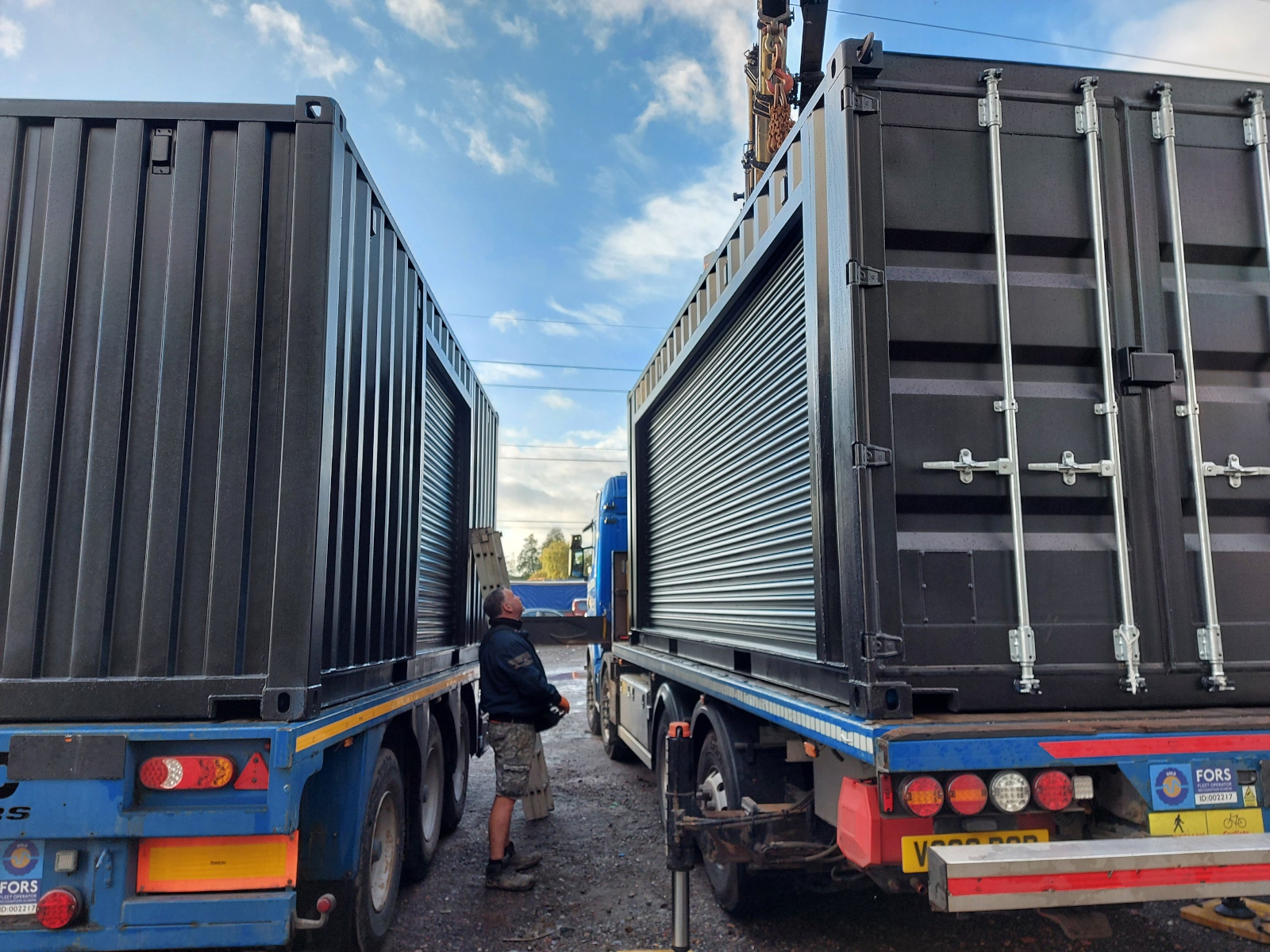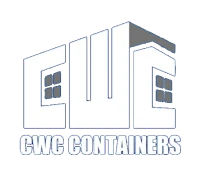Frequently Asked Questions
Standard ISO shipping containers are either 20ft (~6.1m) or 40ft (~12.2m) in length, and all are 8ft (2.44m) wide, to allow them to be efficiently stacked on a cargo ship. They come in two heights, 8ft6 (2.6m) (usually called ‘Dry Van’ or DV) or 9ft6 (2.9m) (called High Cube or HC). See the attached ‘Weights and Dimensions’ chart for further information.
Generally, an empty 20ft shipping container weighs approximately 2230kg. This may differ slightly depending on what door type and locks are fitted.
A fully converted container room will weigh considerably more than this, depending on cladding options and internal fixtures and fittings, but may be in the region of 3300kg when fully timber clad inside and out.
Shipping containers are designed for the harshest environments, as they normally spend their life being lifted and shunted between various cargo ships and crossing oceans all of the world in all weathers, exposed to some of the most extreme and corrosive conditions imaginable.
Made from CorTen steel and sprayed in marine-grade paint, they are extremely strong and resistant to corrosion, so the typical shipping ‘career’ of a container is 20-25+ years, unless it gets significantly damaged during it’s working life (which does happen!).
So a well-maintained converted container room, sitting in a sheltered garden, wrapped in beautiful timber cladding, with a warm and dry interior would, quite reasonably, be expected to last for generations.
Once your order has been placed and the project has been started, we will keep you constantly updated via email or phone, and regular progress photographs will be availble.
Feel free to call us, or email us at helo@cwc-containers.co.uk, any time if you have any questions or would like to pop down to our site for a visit to see the progress for yourself.
On completion and delivery of your conversion, you will be supplied with all the relevant electrical certification as well as a complete Operation & Maintenance (O&M) Manual.
A bit like an Owner’s Manual you would get for your car, an O&M Manual contains all the relevant manufacturers’ product information and instructions for the different elements that have gone into your new container room, whether it be the timber used for the cladding, the underfloor heating system, or the doors and windows, with guidance on all the necessary or recommended on-going maintenance required to keep your new space in tip-top condition.
Shipping containers are classed as temporary structures, so should not need formal planning permission. Having said that, it is always worth checking with your Local Planning Authority to make sure, as different areas have different requirements.
In short, it depends…
A shipping container, by its very nature, is designed for easy transportation. They are manufactured to standardised dimensions to allow for quick and easy lifting, moving and stacking. Having said that, they are big and cumbersome brutes, so some planning is required to ensure efficient delivery.
The 20ft containers, and converted container rooms we specialise in, are delivered using rigid lorry-mounted cranes or lorry-loaders, often known as ‘Hiabs’ (see example photographs below). Depending on which vehicle is used and the weight of the load, these cranes generally have a lifting radius of around 5-10 metres, so the following things need to be considered before ordering:
A fully converted container room will weigh considerably more than this, depending on cladding options and internal fixtures and fittings, but may be in the region of 3300kg when fully timber clad inside and out.
- Is there an adequate tarmac or hardstanding access available to get the vehicle close enough to the container room’s final position?
- Is the lifting area flat and level?
- Is there enough space in the lifting area for the stabiliser legs to fully extend for lifting (approx. 6m across)?
- Are there any underground services or utilities in the lifting area to be aware of?
- Are there any overhead obstructions or restrictions that may affect the lift, or access to the lifting area?
The cost for local delivery onto a pre-prepared spot via lorry-loader is included in the price of our conversions, but please bear in mind that additional costs may be involved for long-distance deliveries.
If it is unfeasible for the lorry-loader to lift the unit to its final position, then it is advisable to seek the assistance of a dedicated lifting company who would be able to carry out a site visit and advise the best solution for you. This is best done BEFORE ordering with us, to avoid any disappointments or abortive costs.
Of course, if you have any queries or concerns with any of this or any advice on additional lifting requirements, we’ll be happy to talk it through with you before taking the process any further.


A completed container room will likely weigh in excess of 3000kg (about the weight of two small family cars), so good firm and level ground is essential to avoid any movement over time. If the unit does move, or is placed on uneven ground, it may twist slightly. This may not be noticeable when you’re stood in it, but it may well impact on how the doors and windows open and close, leading to catching latches and stiff operation.
As all ground conditions are different, it is very difficult to advise on an acceptable base, and advice should be sought from a professional, but we would recommend a minimum of railway sleepers or concrete paving slabs under each corner, ensuring they are set perfectly level with each other.
We recommend that a free air gap is maintained under the unit to prevent any issues with damp in the future, but please bear in mind that the higher you set the foundation, the higher the step up to the door threshold will be (unless of course, you intend to have a lovely deck out front!).
Condensation is the bane of all shipping containers. This is mainly because shipping containers are basically a big steel box with no insulation protecting that steel from the temperature differential between inside and outside.
Warm air can hold more moisture than cold air, and because the air outside tends to be colder than the air inside, the uninsulated steel is cooled to below the dew-point temperature of the warmer air inside. As soon as the warmer air inside touches the cold steel, the moisture in that air instantly condenses out, forming the dreaded water droplets clinging to the inside of the container.
To avoid this, you can do a number of things:
1. Prevent the warm air inside making contact with the colder inside face of the steel (ie: internally insulate the floor, walls and ceiling). At CWC Containers, we fully insulate all walls, ceiling and floor internally.
2. Prevent the cold air outside making contact with the steel to avoid the steel cooling down excessively in the first place (ie: externally insulate the steel shell of the container). At CWC Containers, we also insulate and cover the roof externally. Any external cladding will also act as external protection to the elements.
3. Ventilate the area to allow the air movement to aid with evaporation and removal of the moisture in more favourable conditions. All our containers and container rooms have weatherproof ventilation within the ceiling void (between the steel skin and the internally insulated walls).
4. Remove the moisture from the air inside. If there’s no moisture in the air to condense, then no condensation can form! All our containers and container rooms include one of a number of heating options. It is recommended to maintain a low-level of heat inside the room to keep any damp air at bay. In addition, we would recommend the use of a dehumidifier to further avoid the build-up of mosture in the air.
Again, this largely depends on the level of specification and the options chosen. More bespoke items tend to have longer ‘lead-in’ (manufacture and delivery) times from suppliers. For example some windows and doors have been known to take 12 weeks, and that’s before we’ve even started fitting them.
Generally, we would hope to be able to deliver your container room to you within 6-8 weeks from confirmed order, but we will keep you constantly updated with regular progress updates throughout the process.
Once we have discussed your requirements and you confirm your specification and any options, we ask for a 50% deposit to enable the order to go into production.
On completion of the container room, and having had the opportunity to visit the project in person or view progress photographs and videos, the remaining balance will be due, prior to delivery.
We offer a 12-month warranty, from the date of delivery. During this period, we will repair or replace products or parts of a product that proves defective because of improper material or workmanship, under normal use and maintenance.
Every insurance company offers differing levels of cover, but any container conversion located on your property will probably be classed as an outbuilding and so wouldn’t necessarily be covered as part of your main house. Please check with your insurance company to ensure that outbuildings are covered within your policy.
CWC Container conversions are pre-fabricated units, ready to lift into position and ‘plug and play’
A huge advantage for the likes of construction companies and developers is the fact that our container rooms can be delivered and lifted into position in a matter of minutes, and are ready to be simply plugged into a power supply and turned on! All this means minimal disruption to other site activities!
Please see our Terms and conditions of business.
